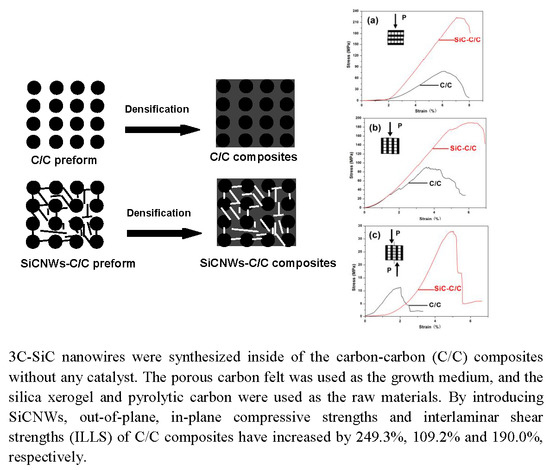3C-SiC Nanowires In-Situ Modified Carbon/Carbon Composites and Their Effect on Mechanical and Thermal Properties
Abstract
:1. Introduction
2. Experimental Section
2.1. Preparation of SiCNW-C/C Composites
2.2. Characterization
2.3. Test of Mechanical Properties
3. Results and Discussion
3.1. Morphology of SiCNWs
3.2. Phase and Structure Characterization
3.3. Reactivity of SiCNWs
3.4. Thermal Analysis
3.5. Mechanical Properties
3.6. Fracture Surfaces
4. Conclusions
Author Contributions
Acknowledgments
Conflicts of Interest
References
- Xie, J.B.; Liang, J.; Fang, G.D.; Chen, Z. Effect of needling parameters on the effective properties of 3D needled C/C-SiC composites. Compos. Sci. Technol. 2015, 117, 69–77. [Google Scholar] [CrossRef]
- Poitrimolt, M.; Cheikh, M.; Bernhart, G.; Velay, V. Characterisation of the transverse mechanical properties of carbon/carbon composites by spherical indentation. Carbon 2014, 66, 234–245. [Google Scholar] [CrossRef]
- Huo, C.X.; Guo, L.J.; Wang, C.C.; Kou, G.; Song, H.T. Microstructure and ablation mechanism of SiC-ZrC-Al2O3 coating for SiC coated C/C composites under oxyacetylene torch test. J. Alloys Compd. 2018, 735, 914–927. [Google Scholar] [CrossRef]
- Fan, X.M.; Yin, X.W.; Cao, X.Y.; Chen, L.Q.; Cheng, L.F.; Zhang, L.T. Improvement of the mechanical and thermophysical properties of C/SiC composites fabricated by liquid silicon infiltration. Compos. Sci. Technol. 2015, 115, 21–27. [Google Scholar] [CrossRef]
- Chen, J.; Tian, C.; Luan, X.G.; Xiao, P.; Xiong, X. The mechanical property and resistance ability to atomic oxygen corrosion of boron modified carbon/carbon composites. Mater. Sci. Eng. A 2014, 610, 126–131. [Google Scholar] [CrossRef]
- Lu, X.F.; Xiao, P.; Chen, J.; Long, Y. Oxidation behavior of C/C composites with the fibre/matrix interface modified by carbon nanotubes grown in situ at low temperature. Corros. Sci. 2012, 55, 20–25. [Google Scholar] [CrossRef]
- Park, S.J.; Seo, M.K.; Lee, D.R. Studies on the mechanical and mechanical interfacial properties of carbon-carbon composites impregnated with an oxidation inhibitor. Carbon 2003, 41, 2991–3002. [Google Scholar] [CrossRef]
- Chen, J.; Xiao, P.; Xiong, X. The mechanical properties and thermal conductivity of carbon/carbon composites with the fiber/matrix interface modified by silicon carbide nanofibers. Mater. Des. 2015, 84, 285–290. [Google Scholar] [CrossRef]
- Li, R.; Lachman, N.; Florin, P.; Wagner, H.D.; Wardle, B.L. Hierarchical carbon nanotube carbon fiber unidirectional composites with preserved tensile and interfacial properties. Compos. Sci. Technol. 2015, 117, 139–145. [Google Scholar] [CrossRef] [Green Version]
- Wu, S.; Liu, Y.Q.; Ge, Y.C.; Ran, L.P.; Peng, K.; Yi, M.Z. Surface structures of PAN-based carbon fibers and their influences on the interface formation and mechanical properties of carbon-carbon composites. Compos. Part A 2016, 90, 480–488. [Google Scholar] [CrossRef]
- Song, Q.; Li, K.Z.; Li, H.L.; Li, H.J.; Ren, C. Grafting straight carbon nanotubes radially onto carbon fibers and their effect on the mechanical properties of carbon/carbon composites. Carbon 2012, 50, 3949–3952. [Google Scholar] [CrossRef]
- Lu, X.F.; Xiao, P. Preparation of in situ grown silicon carbide nanofibers radially onto carbon fibers and their effects on the microstructure and flexural properties of carbon/carbon composites. Carbon 2013, 59, 176–183. [Google Scholar] [CrossRef]
- Dai, W.; Yu, J.H.; Liu, Z.D.; Wang, Y.; Song, Y.Z.; Lyu, J.L.; Bai, H.; Nishimura, K.; Jiang, N. Enhanced thermal conductivity and retained electrical insulation for polyimide composites with SiC nanowires grown on graphene hybrid fillers. Compos. Part A 2015, 76, 73–81. [Google Scholar] [CrossRef]
- Dong, R.H.; Yang, W.S.; Wu, P.; Hussain, M.; Xiu, Z.Y.; Wu, G.H.; Wang, P.P. Microstructure characterization of SiC nanowires as reinforcements in composites. Mater. Charact. 2015, 103, 37–41. [Google Scholar] [CrossRef]
- Zhang, Y.L.; Hu, M.; Qin, X.G.; Song, X.G. The influence of additive content on microstructure and mechanical properties on the C-sf/SiC composites after annealed treatment. Appl. Surf. Sci. 2013, 279, 71–75. [Google Scholar]
- Yang, W.; Araki, H.; Tang, C.C.; Thaveethavorn, S.; Kohyama, A.; Suzuki, H.; Noda, T. Single-crystal SiC nanowires with a thin carbon coating for stronger and tougher ceramic composites. Adv. Mater. 2005, 17, 1519–1523. [Google Scholar] [CrossRef]
- Wu, R.B.; Zhou, K.; Yue, C.Y.; Wei, J.; Pan, Y. Recent progress in synthesis, properties and potential applications of SiC nanomaterials. Prog. Mater. Sci. 2015, 72, 1–60. [Google Scholar] [CrossRef] [Green Version]
- Li, J.; Zhu, X.L.; Ding, P.; Chen, Y.P. The synthesis of twinned silicon carbide nanowires by a catalyst-free pyrolytic deposition technique. Nanotechnology 2009, 20, 145602. [Google Scholar] [CrossRef] [PubMed]
- Dong, Z.J.; Meng, J.; Zhu, H.; Yuan, G.M.; Cong, Y.; Zhang, J.; Li, X.K.; Westwood, A. Synthesis of SiC nanowires via catalyst-free pyrolysis of silicon-containing carbon materials derived from a hybrid precursor. Ceram. Int. 2017, 43, 11006–11014. [Google Scholar] [CrossRef] [Green Version]
- Lin, H.J.; Li, H.J.; Qu, H.Y.; Li, L.; Shi, X.H.; Guo, L.J. In situ synthesis of SiOC ceramic nanorod-modified carbon/carbon composites with sol-gel impregnation and CVI. J. Sol-Gel Sci. Technol. 2015, 76, 11–18. [Google Scholar] [CrossRef]
- Luna, L.E.; Ophus, C.; Johanson, J.; Maboudian, R.; Carraro, C. Demonstration of hexagonal phase silicon carbide nanowire arrays with vertical alignment. Cryst. Growth Des. 2016, 16, 2887–2892. [Google Scholar] [CrossRef]
- Han, M.K.; Yin, X.W.; Duan, W.Y.; Ren, S.; Zhang, L.T.; Cheng, L.F. Hierarchical graphene/SiC nanowire networks in polymer-derived ceramics with enhanced electromagnetic wave absorbing capability. J. Eur. Ceram. Soc. 2016, 36, 2695–2703. [Google Scholar] [CrossRef]
- Zhang, X.D.; Huang, X.X.; Wen, G.W.; Geng, X.; Zhu, J.D.; Zhang, T.; Bai, H.W. Novel SiOC nanocomposites for high-yield preparation of ultra-large-scale SiC nanowires. Nanotechnology 2010, 21, 385601. [Google Scholar] [CrossRef] [PubMed]
- Schoell, S.J.; Sachsenhauser, M.; Oliveros, A.; Howgate, J.; Stutzmann, M.; Brandt, M.S.; Frewin, C.L.; Saddow, S.E.; Sharp, I.D. Organic functionalization of 3C-SiC surfaces. ACS Appl. Mater. Interfaces 2013, 5, 1393–1399. [Google Scholar] [CrossRef] [PubMed]
- Pan, J.M.; Yan, X.H.; Cheng, X.N.; Shen, W.; Li, S.X.; Cai, X.L. In situ synthesis and electrical properties of porous SiOC ceramics decorated with SiC nanowires. Ceram. Int. 2016, 42, 12345–12351. [Google Scholar] [CrossRef]
- Zeng, Y.; Xiong, X.; Wang, D.N.; Wu, L. Residual thermal stresses in carbon/carbon-Zr-Ti-C composites and their effects on the fracture behavior of composites with different preforms. Carbon 2015, 81, 597–606. [Google Scholar] [CrossRef]
- Meng, A.; Li, Z.J.; Zhang, J.L.; Gao, L.; Li, H.J. Synthesis and raman scattering of beta-SiC/SiO2 core-shell nanowires. J. Cryst. Growth 2007, 308, 263–268. [Google Scholar] [CrossRef]
- Chen, Z.M.; Ma, J.P.; Yu, M.B.; Wang, J.N.; Ge, W.K.; Woo, P.W. Light induced luminescence centers in porous SiC prepared from nano-crystalline SiC grown on Si by hot filament chemical vapor deposition. Mater. Sci. Eng. B-Solid 2000, 75, 180–183. [Google Scholar] [CrossRef]
- Wu, R.B.; Yang, G.Y.; Gao, M.X.; Li, B.S.; Chen, J.J.; Zhai, R.; Pan, Y. Growth of SiC Nanowires from NiSi Solution. Cryst. Growth Des. 2009, 9, 100–104. [Google Scholar] [CrossRef]
- Li, Z.J.; Zhang, J.L.; Meng, A.; Guo, J.Z. Large-area highly-oriented SiC nanowire arrays: Synthesis, Raman, and photoluminescence properties. J. Phys. Chem. B 2006, 110, 22382–22386. [Google Scholar] [CrossRef] [PubMed]
- Li, J.Y.; Zhang, Y.F.; Zhong, X.H.; Yang, K.Y.; Meng, J.; Cao, X.Q. Single-crystalline nanowires of SiC synthesized by carbothermal reduction of electrospun PVP/TEOS composite fibres. Nanotechnology 2007, 18, 3999–4002. [Google Scholar] [CrossRef]
- Mazo, M.A.; Nistal, A.; Caballero, A.C.; Rubio, F.; Rubio, J.; Oteo, J.L. Influence of processing conditions in TEOS/PDMS derived silicon oxycarbide materials. Part 1: Microstructure and properties. J. Eur. Ceram. Soc. 2013, 33, 1195–1205. [Google Scholar] [CrossRef]
- Liang, T.A.; Li, Y.L.; Su, D.; Du, H.B. Silicon oxycarbide ceramics with reduced carbon by pyrolysis of polysiloxanes in water vapor. J. Eur. Ceram. Soc. 2010, 30, 2677–2682. [Google Scholar] [CrossRef]
- Chen, J.H.; Liu, W.N.; Yang, T.; Li, B.; Su, J.D.; Hou, X.M.; Chou, K.C. A facile synthesis of a three-dimensional flexible 3C-SiC sponge and its wettability. Cryst. Growth Des. 2014, 14, 4624–4630. [Google Scholar] [CrossRef]
- Lin, L.W. Synthesis and optical property of large-scale centimetres-long silicon carbide nanowires by catalyst-free CVD route under superatmospheric pressure conditions. Nanoscale 2011, 3, 1582–1591. [Google Scholar] [CrossRef] [PubMed]
- Wu, R.B.; Li, B.S.; Gao, M.X.; Chen, J.J.; Zhu, Q.M.; Pan, Y. Tuning the morphologies of SiC nanowires via the control of growth temperature, and their photoluminescence properties. Nanotechnology 2008, 19, 335602. [Google Scholar] [CrossRef] [PubMed]
- Feng, L.; Li, K.Z.; Xue, B.; Fu, Q.G.; Zhang, L.L. Optimizing matrix and fiber/matrix interface to achieve combination of strength, ductility and toughness in carbon nanotube-reinforced carbon/carbon composites. Mater. Des. 2017, 113, 9–16. [Google Scholar] [CrossRef]

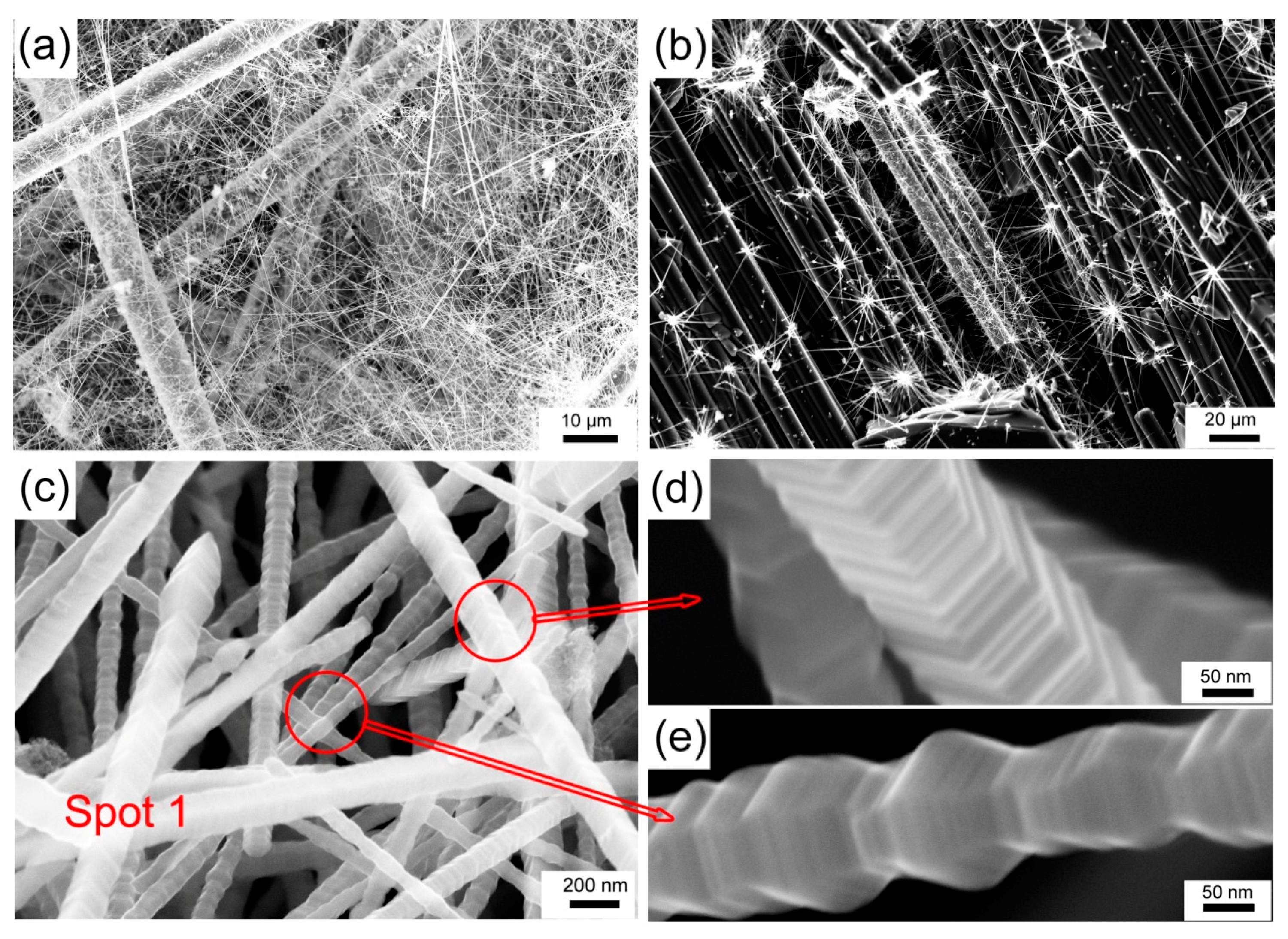
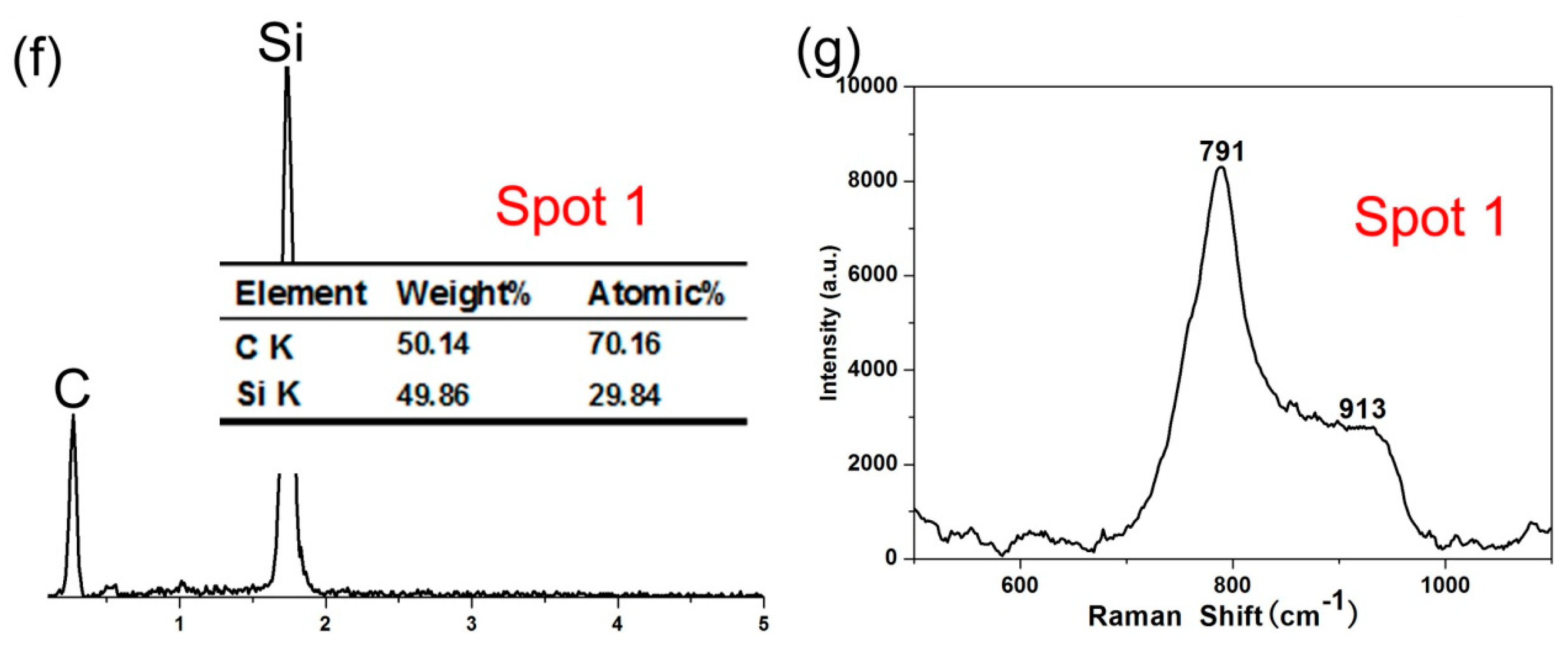
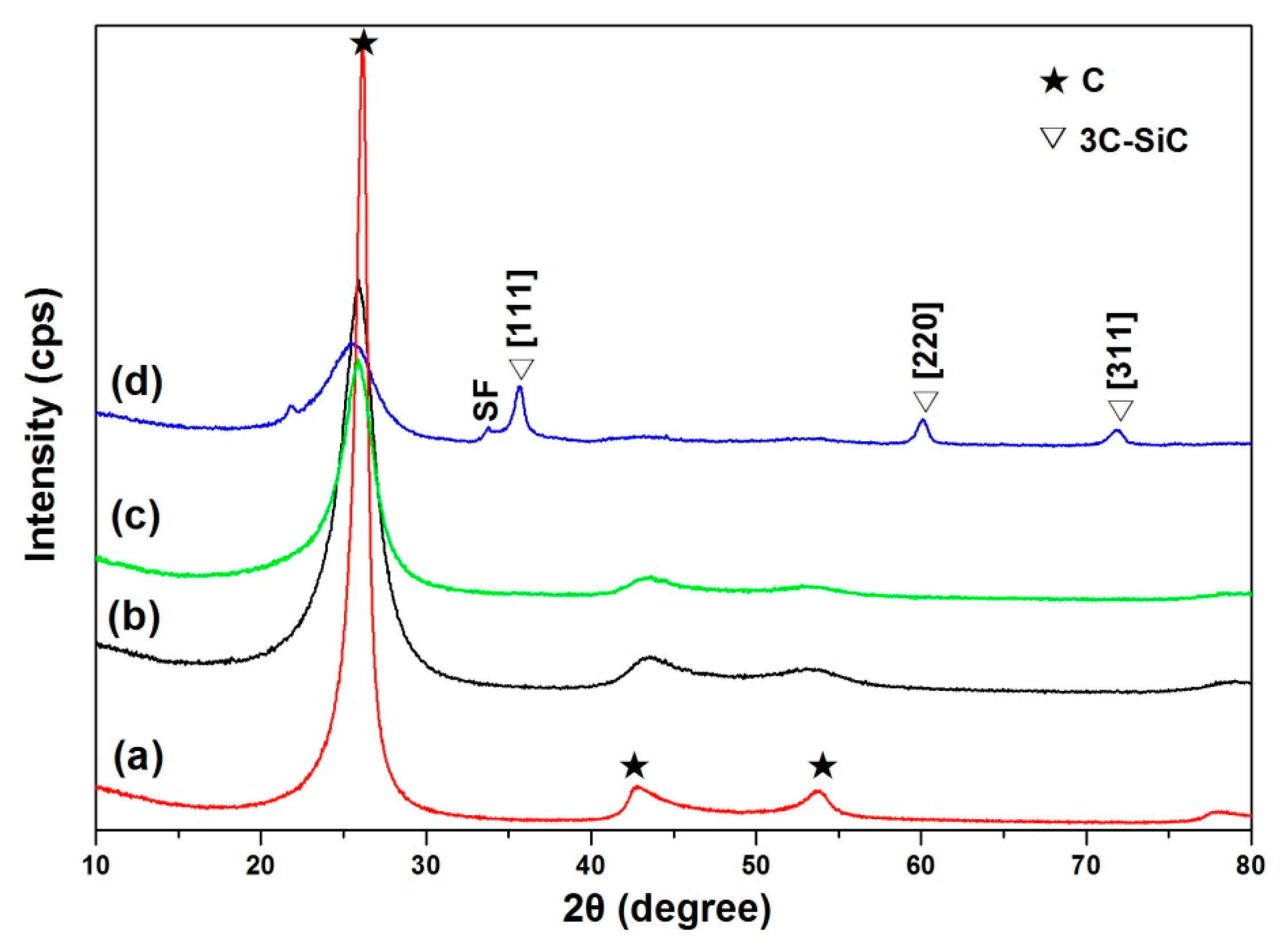
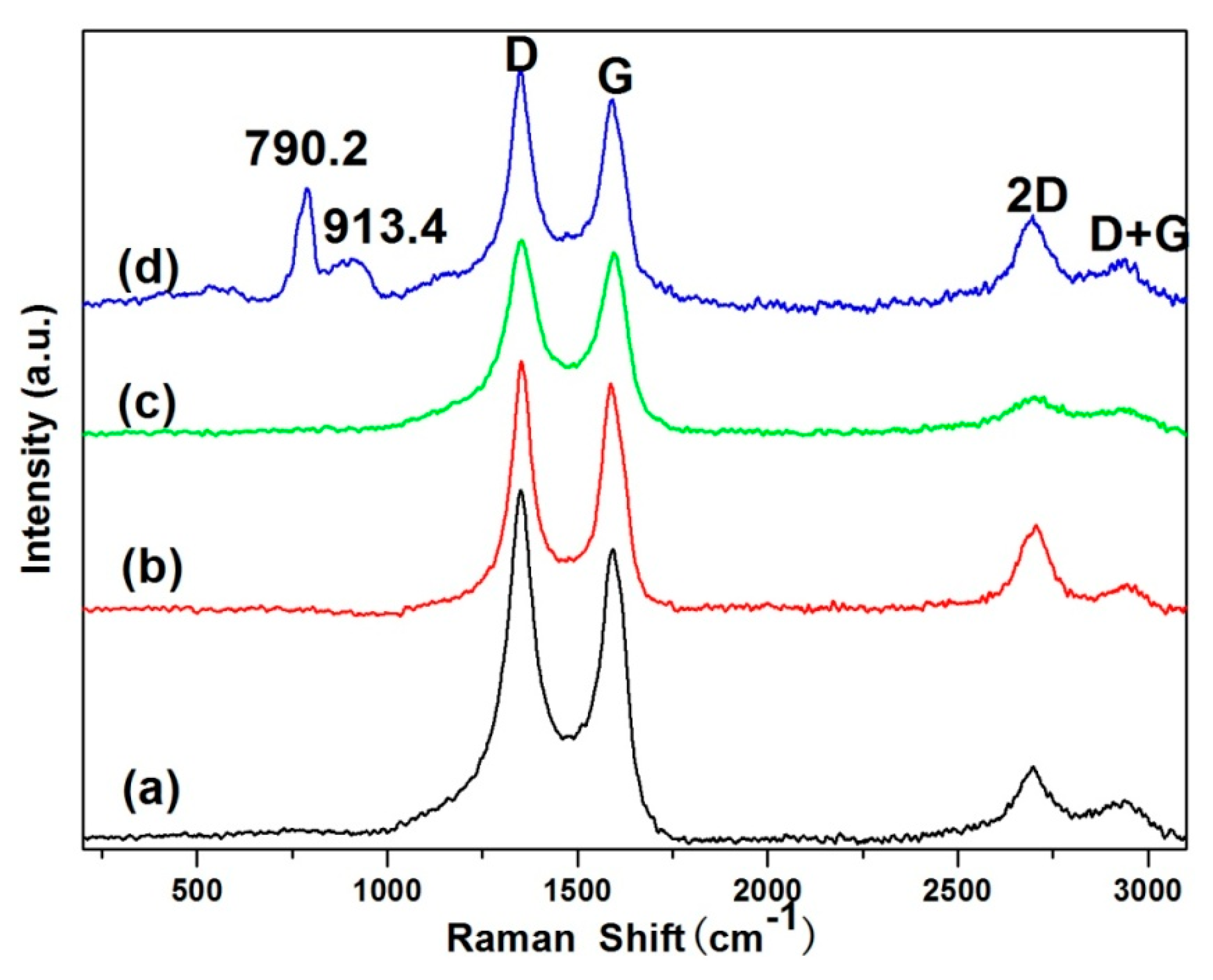

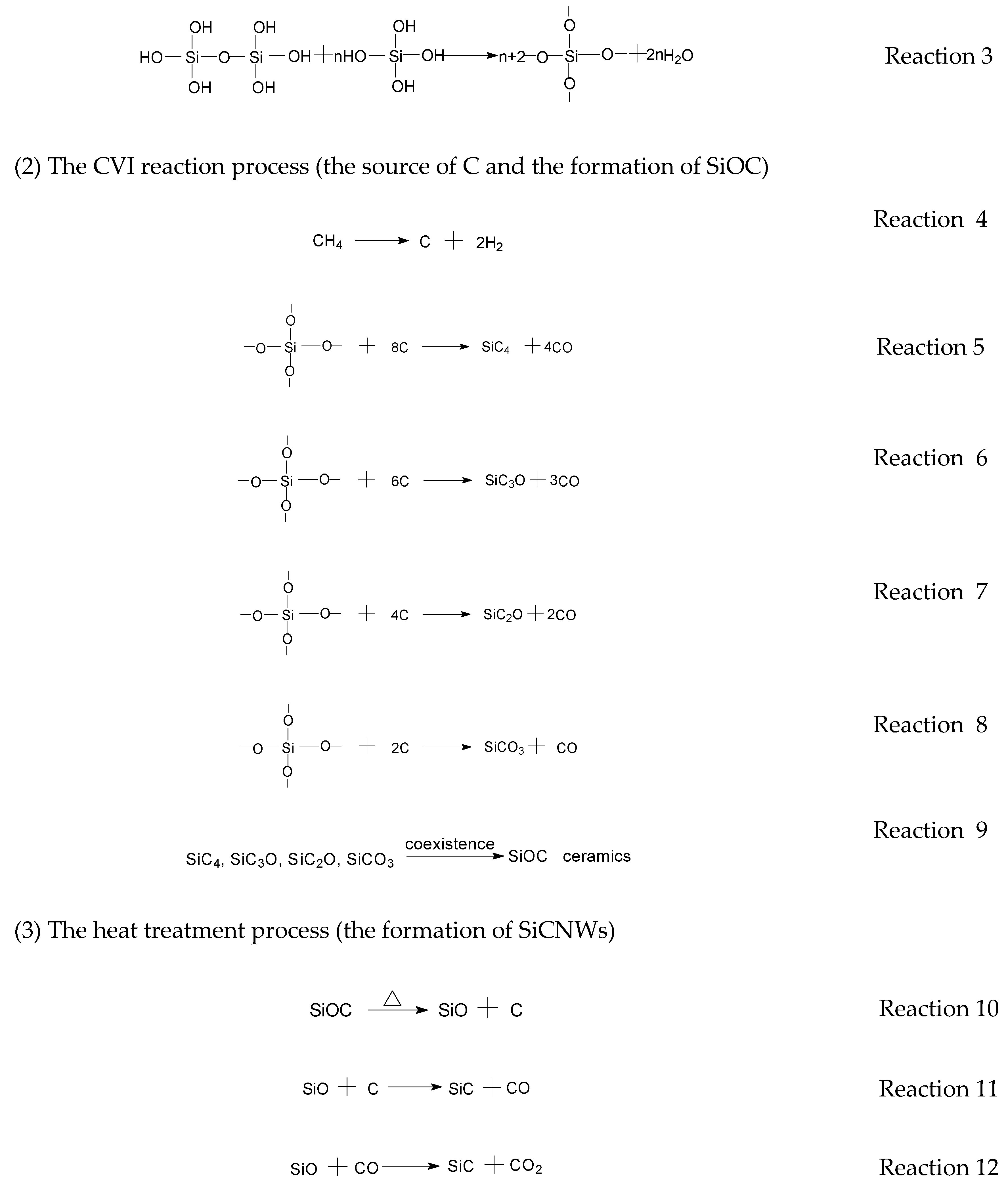


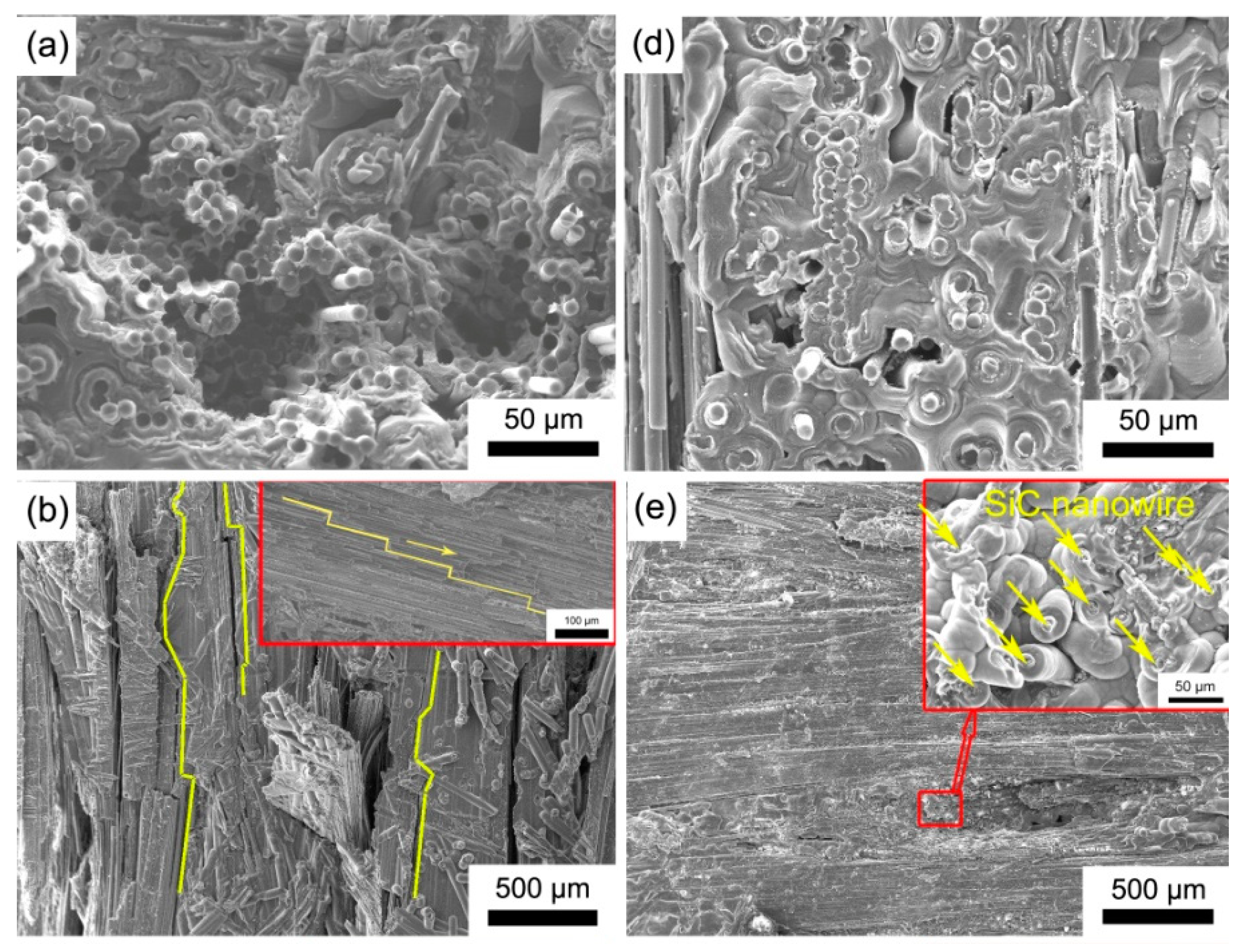

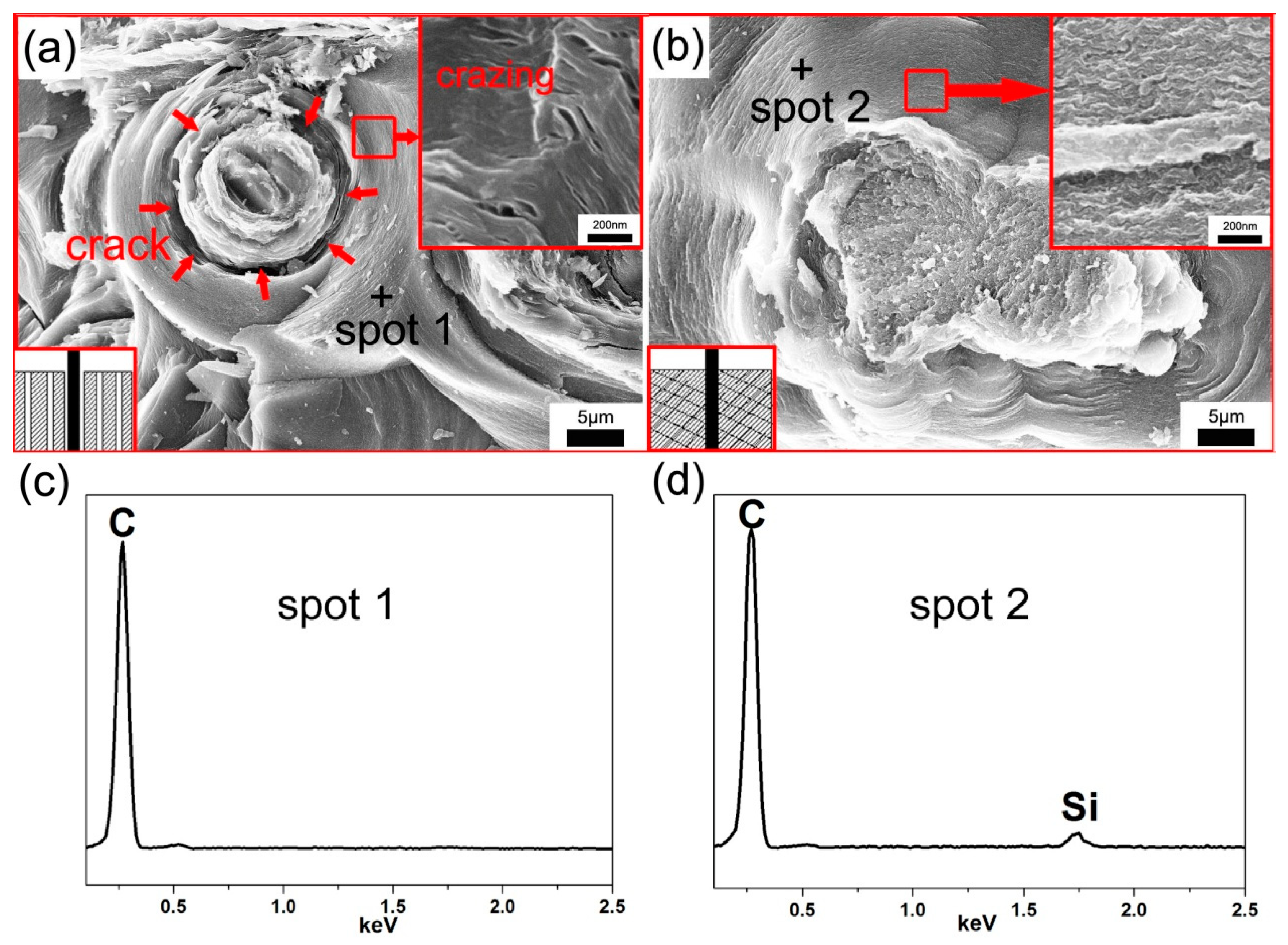
| Samples | Out-Of-Plane Compression | In-Plane Compression | ILSS | ||
|---|---|---|---|---|---|
| σ (MPa) | E (GPa) | σ (MPa) | E (GPa) | τ (MPa) | |
| C/C | 68.18 | 2.72 | 90.84 | 1.99 | 11.36 |
| SiCNW-C/C | 223.13 | 4.05 | 190.06 | 4.21 | 32.94 |
| Increment (%) | 249.3% | 48.9% | 109.2% | 111.6% | 190.0% |
© 2018 by the authors. Licensee MDPI, Basel, Switzerland. This article is an open access article distributed under the terms and conditions of the Creative Commons Attribution (CC BY) license (http://creativecommons.org/licenses/by/4.0/).
Share and Cite
Lin, H.; Li, H.; Shen, Q.; Shi, X.; Feng, T.; Guo, L. 3C-SiC Nanowires In-Situ Modified Carbon/Carbon Composites and Their Effect on Mechanical and Thermal Properties. Nanomaterials 2018, 8, 894. https://doi.org/10.3390/nano8110894
Lin H, Li H, Shen Q, Shi X, Feng T, Guo L. 3C-SiC Nanowires In-Situ Modified Carbon/Carbon Composites and Their Effect on Mechanical and Thermal Properties. Nanomaterials. 2018; 8(11):894. https://doi.org/10.3390/nano8110894
Chicago/Turabian StyleLin, Hongjiao, Hejun Li, Qingliang Shen, Xiaohong Shi, Tao Feng, and Lingjun Guo. 2018. "3C-SiC Nanowires In-Situ Modified Carbon/Carbon Composites and Their Effect on Mechanical and Thermal Properties" Nanomaterials 8, no. 11: 894. https://doi.org/10.3390/nano8110894



